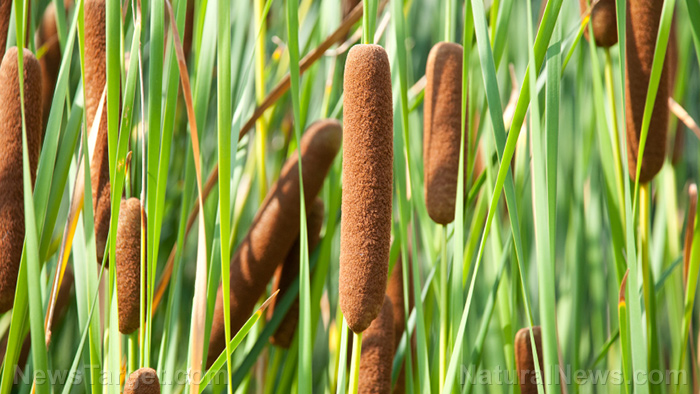
Advertisement
You may have seen these corn dog-looking flower spikes growing in freshwater wetlands and smaller bodies of water. These plants, commonly called cattails, really deserve more attention. You might not realize it, but cattails are packed with vitamins and minerals, which make them an excellent source of nutrition during emergencies. When SHTF, you can avoid starvation by learning how to identify and use cattails. (h/t to UrbanSurvivalSite.com)
Also known as bulrushes or greater reed mace, cattails are wild edibles that are incredibly easy to find. Some of the nutrients that can be found in cattails include phosphorus, potassium, manganese and vitamins A and C, as well as B-vitamins. The two common species of cattails are Typha angustifolia (narrowleaf cattail) and Typha latifolia (broadleaf cattail). Both varieties are completely edible when prepared properly. (Related: Survival food: More wild edible roots you can hunt and gather.)
How to identify cattails
Cattails usually grow about six to nine feet tall in the wild. They can be easily identified by their brown cylindrical flower spikes, which resemble cigars or corn dogs. During the early fall season, these flower spikes open up, exposing an abundance of puffy seeds hidden inside. Each cattail shoot has roughly 15 leaves that can be green or pale gray in color and joined together at a base. These thick, flat leaves look like ribbons that are rounded at the back and have a spongy texture inside and out.
When cattails are in bloom, they are filled with tiny green flowers. Over time, these green flowers turn to a bright shade of yellow. Cattails also have extra roots that grow horizontally from the main root. If you come across a plant that resembles a cattail but has a strong scent, it’s likely not a cattail as this plant has no scent. Once you find a cattail, you must first loosen the mud around its base before pulling it diagonally. The shoot will then easily separate from the main plant. Cattails are best harvested and consumed during the summer months.
How to use cattails
The edible parts of the cattail plant include the white bottom of its stalk, its leaves, flower heads, young tips, main root spurs and young rootlets. The rootlets should be long and thin like spaghetti noodles. You can use those rootlets as an emergency pasta substitute. However, if you want to eat the main roots of the cattail plant, you must first remove the fibrous part as it can cause digestive issues when consumed. Cattail roots should be thoroughly boiled before they are eaten.
The lower part of the cattail stem tastes like cucumber when eaten raw and like corn on the cob when cooked. You can eat raw cattail leaves or use them to make a salad. Young cattail stems can also be eaten raw, but they taste best when boiled. Meanwhile, the pollen from cattail flower heads can be used as a shelf-stable substitute for flour. With its starchy yet mild flavor, cattail pollen is a great addition to pancakes and other recipes.
Cattail flowers can be roasted on an open fire. Other recommended cattail recipes include scalloped cattails, cattail casserole and cattail biscuits. Experiment with cattail and find new ways to enjoy this highly underrated survival food by adding it to your dishes.
Learn about other survival foods you can forage by visiting Survival.news.
Sources include:
Advertisement
Advertisements
















